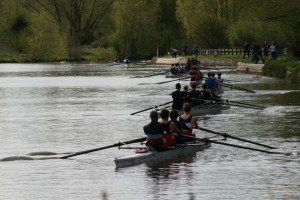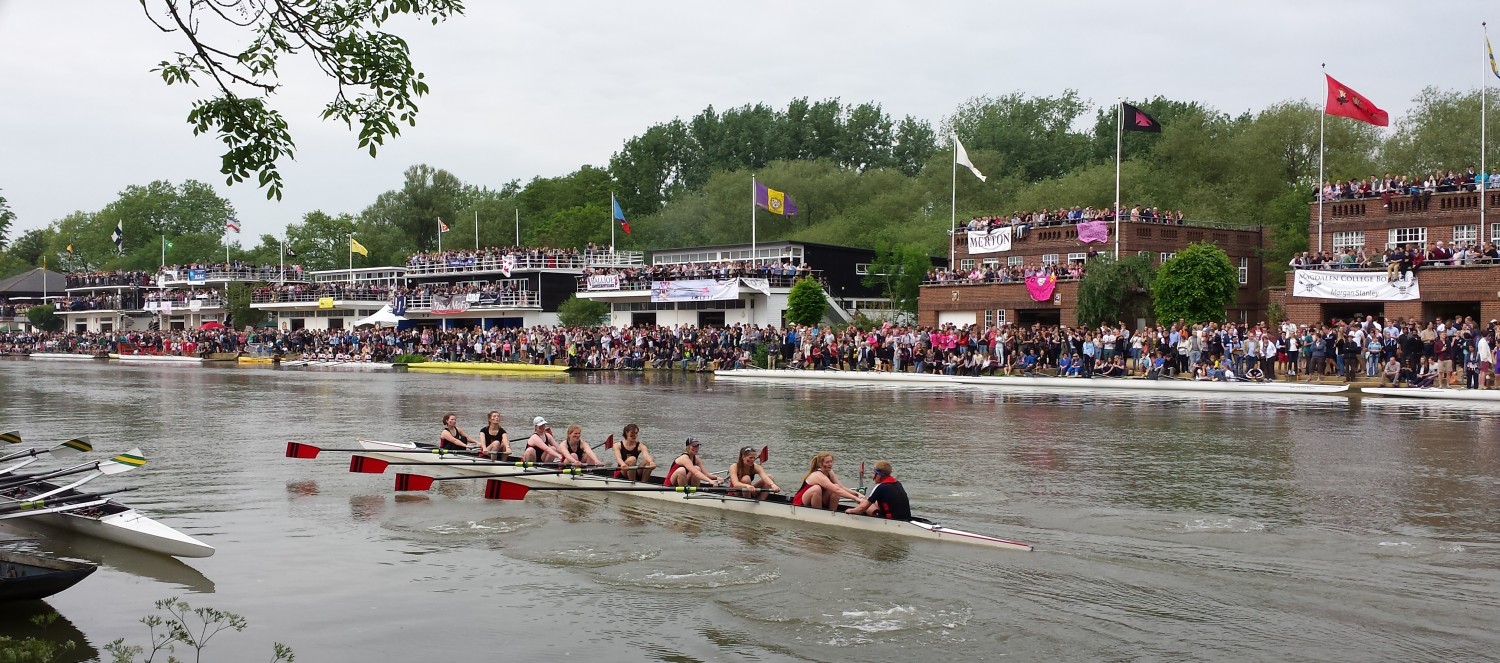Know your Centre of Rotation.
 By Howard Aiken
By Howard Aiken
Luckily, just beside my rowing club, a road bridge crosses the river. One can stand on that bridge and watch boats pass underneath. I actually advise our beginners to do this, because rowing as seen from the rower’s point of view and rowing as seen from a bridge above the river differ in several key respects.
From the rower’s point of view, the catch is taken behind his or her seat i.e. with the spoon toward the bows of the boat while they are at frontstops. During the power phase of the stroke, the spoon moves past the rower toward the stern until the rower reaches the finish and the blade is extracted at the end of the stroke. If you ask most rowers to pinpoint the blade’s centre of rotation, the point around which they are working to apply force to the blade they will probably point to the pin. (The pin, in case some readers don’t know, is the vertical post at the end of the rigger on which the swivel turns).
From the bridge, the view is rather different. It is a view dominated by the motion of the boat as it comes towards us. Looking down, we can see that as the blades enter the water at the catch they appear to ‘lock’, remaining stationary in the water as the boat continues past them. The angle between blade and boat changes with the forward motion of the boat and as it does so the spoon makes a small movement outward, away from the boat so that the tip of the spoon is furthest from the boat as the blade passes through the 90 degree right angle. Once that point is passed, the tip of the spoon moves back toward the boat as it moves on, before the blades are extracted from the water. There are some good diagrams to show this movement here: www.concept2.co.uk/blade-path .
This video clip (the 2014 Boat Race seen from Hammersmith Bridge) also illustrates the movement – start from the 1.00 minute mark:
Video credit to Pier Paolo Ciarravano at http://www.larmor.com/
Which brings me to the point of this blog. To the rower, the centre of rotation appears to be the pin at the end of the rigger. From the rower’s point of view it may therefore seem sensible to bury not just the spoon but a couple of feet of the loom in the water during the power phase of the stroke, because if the pin is the centre of rotation then all that additional surface area in the water is helping to transmit the rower’s awesome power to the water and hence increasing the speed of the boat. In reality, the centre of rotation is close to the tip of the spoon and every part of the blade inboard of that point is moving in the same direction as the boat. Spoon and loom are therefore subject to the very considerable ‘drag’ of the water which has to be pushed out of the way to allow for that motion.
As its name implies, ‘drag’ is THE big negative of the sport of rowing. It is the water’s resistance to the movement of a solid body and most boat designers spend most of their time trying to minimise it, because it is the single biggest energy drain on a boat in motion. Designers measure the ‘wetted area’ of a hull because they know that the more surface area they have in the water the more drag they have on the boat. I apply the same logic in coaching rowers. Having too much blade in the water – whatever else it may do – creates significant drag.
Rowers need to understand that their centre of rotation is out beyond the pin, at the tip of the blade. When they understand that, they can understand how to use the blade efficiently. I ask them to respect the designers who have crafted their blades to float with the top edge of the spoon at the surface of the water and the loom out of the water and I run drills to get rowers to treat the catch as part of the recovery rather than part of the stroke – dropping the blade onto the water and feeling its bouyancy rather than rowing it forcefully into the water and burying it.
There is of course another school of thought which recommends ‘rowing deep’ with the spoon and much of the loom in the water (there is a discussion here for example: groups.google.com/forum/rec.sport.rowing) and certainly if you watch elite scullers, most use more blade in the water than I am recommending here. Does this change my view? No, it doesn’t and for the following reason. Elite scullers have to use equipment which complies with the same rules as the rest of us. However, they are applying far greater force in the water with that equipment than even a good club or university rower. That amount of energy applied to a sculling blade at normal depth would disrupt the ‘normal’ hydrodynamics of the spoon – they would in effect lose their grip on the water during the power phase of the stroke. They therefore have to row deeper to enable the blade to deliver their much greater power to the water. The trade-off in terms of increased drag is one they are happy to accept as they are still moving the boat faster than they would do at the shallower depth.
The temptation to row ‘like an elite rower’ is understandable, but unless you’re also going to train like an elite rower, it is about as productive as strapping on an 80 pound backpack for a hiking weekend so that you can march ‘like a Marine’ (http://www.royalmarines.uk/carrying-a-heavy-bergen).
